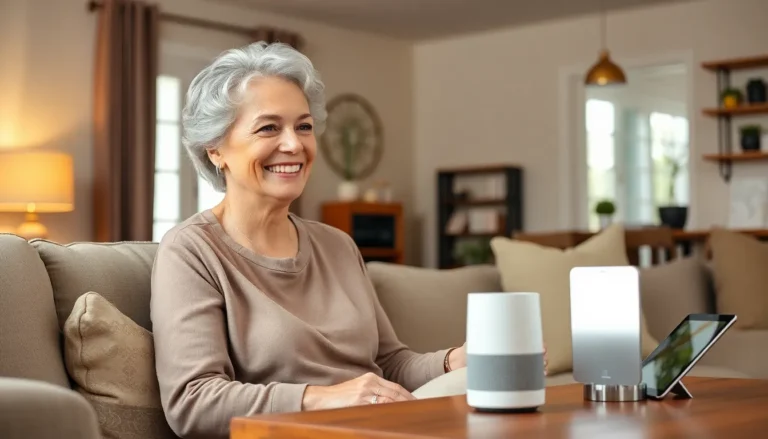Table of Contents
ToggleImagine a world where your devices actually listen to you—no more yelling at your smart speaker while it plays the wrong playlist. Enter cross-platform smart control, the tech wizardry that makes your gadgets work together like a well-rehearsed dance troupe. It’s the magic that turns your smartphone, tablet, and smart home devices into a seamless symphony of convenience.
With cross-platform smart control, you can manage everything from your thermostat to your coffee maker with just a few taps. Whether you’re at home or on the go, this technology ensures you’re always in charge. So why settle for a chaotic tech life when you can orchestrate your devices like a pro? Get ready to embrace the future of smart living—where control is just a click away and your devices finally understand your commands (and maybe your jokes too).
Overview Of Cross-Platform Smart Control
Cross-platform smart control integrates multiple devices, enabling seamless communication between smart technologies. This technology simplifies managing devices like lights, security cameras, and household appliances from various platforms. Users benefit from increased flexibility, allowing them to control their environments through smartphones, tablets, or dedicated control panels.
Interoperability plays a crucial role in cross-platform smart control. Devices from different manufacturers communicate effectively, creating a cohesive user experience. Standard protocols, such as Wi-Fi, Zigbee, and Z-Wave, facilitate this interaction, ensuring compatibility across various ecosystems.
Convenience significantly improves with smart control systems. Users can customize settings based on preferences, automate routines, and even monitor energy consumption. For instance, a user might schedule their thermostat to adjust temperatures based on occupancy patterns, contributing to energy savings.
Data security remains a vital component in cross-platform smart control. Protecting user information and maintaining privacy is essential as smart devices collect and transmit data. Manufacturers emphasize robust encryption techniques and user authentication to safeguard personal data against potential threats.
Adoption rates for cross-platform smart control solutions continue to rise. More homes integrate smart devices, enhancing overall convenience and efficiency. Market studies indicate that consumers value the ability to manage multiple devices through a single interface, which streamlines daily tasks.
Ultimately, cross-platform smart control reshapes everyday interactions with technology. This transformation leads to optimized living environments and empowers users to tailor their experiences seamlessly. Through ongoing advancements, the future of smart control promises even greater synchronization and ease of use among various devices.
Benefits Of Cross-Platform Smart Control
Cross-platform smart control offers numerous advantages for users, enhancing convenience and providing a cohesive technology experience across different devices.
Enhanced User Experience
Devices communicate better with cross-platform smart control, leading to a more integrated technology ecosystem. Users enjoy streamlined interactions, as they can manage various devices from a single application. Customization options further improve usability, making it simple to adjust settings based on individual needs. Automation features allow users to set routines that enhance day-to-day living. User-friendly interfaces contribute significantly to overall satisfaction, enabling effortless control of smart home systems.
Increased Flexibility
Flexibility thrives in a cross-platform environment, allowing users to pick and choose devices from different brands without concern for compatibility. This openness encourages innovation, as users can integrate the latest technology into their existing setup. Connectivity across various platforms fosters a more personalized experience, catering to specific preferences. Additionally, managing diverse devices—from lights to security systems—offers users greater control over their environments. As a result, the ability to adapt and modify setups enhances overall smart living experiences.
Popular Platforms For Smart Control
Numerous platforms enable effective cross-platform smart control by integrating various smart devices. These platforms cater to diverse user needs, providing seamless management of technological environments.
Platform A
Amazon Alexa serves as a leading platform for smart control. This voice-activated assistant connects to a wide range of devices, including lights, thermostats, and security cameras. Users can issue voice commands or create routines for automated processes. Alexa boasts compatibility with thousands of third-party devices, ensuring versatility in choices. Routine functionalities allow users to set schedules and triggers, making everyday tasks effortless. With Amazon’s regular updates, compatibility with new devices continually improves, enhancing user experience. Its intuitive app offers centralized control, enabling users to manage all connected devices from one location effectively.
Platform B
Google Home presents another robust option for smart control. This platform integrates with Google Assistant, providing excellent device compatibility. Users enjoy the ability to manage devices through voice commands, making interactions straightforward and user-friendly. Google Home connects to various smart appliances, including speakers, lights, and thermostats. Custom routines can be easily created, allowing users to tailor their smart environment. The Google Home app provides a comprehensive interface, enabling centralized management and monitoring. Its strong focus on interoperability enhances the overall experience, ensuring users can take full advantage of their diverse tech ecosystem.
Challenges In Implementing Cross-Platform Smart Control
Interoperability issues frequently arise when integrating devices from different manufacturers. Standards like Wi-Fi, Zigbee, and Z-Wave enable compatibility, yet not all devices support these protocols. Frequent software updates complicate this integration, as they may introduce compatibility issues among devices.
User experience often suffers due to inconsistencies in control interfaces. Each smart device often comes with its specific app, creating confusion when managing multiple platforms. Complexity increases with varying features and settings, leading to frustration when users try to customize their smart environment.
Data security poses a significant challenge in cross-platform systems. Manufacturers emphasize robust encryption, yet vulnerabilities can still exist. Users must consider the risks associated with reduced password protection or inadequate authentication methods, which may expose personal information.
Cost implications also factor into successful implementation. Smart devices often come with varying price points, affecting widespread adoption. Budget constraints limit the number of devices users can incorporate into their smart ecosystems, potentially hindering the seamless experience sought by many.
Integration difficulties often stem from outdated technology. Older devices may lack the necessary updates, leading to performance issues. As technology evolves rapidly, compatibility with new devices becomes more critical to maintain an efficient cross-platform network.
Troubleshooting common issues frequently challenges users, as they may face obstacles not covered in user manuals. The absence of universal guidelines can lead to misunderstanding or ineffective use of smart devices. These challenges must be addressed to optimize the potential of cross-platform smart control technologies.
Future Trends In Cross-Platform Smart Control
Advancements in artificial intelligence significantly drive cross-platform smart control’s future. Intelligent systems will analyze user behavior, allowing devices to adapt automatically to preferences. Enhanced voice recognition technology will improve compatibility and responsiveness across multiple devices, reducing the need for manual controls.
Increased adoption of 5G networks will facilitate faster communication between devices, creating smoother interactions. Users can expect real-time data sharing and synchronization, making it easier to manage smart homes from anywhere. Seamless integration with augmented and virtual reality technologies may transform how users interact with their environments, providing immersive control experiences.
Cloud technology continues to evolve, supporting more efficient data management. With cloud-based solutions, users can access their devices and control settings from any location. This shift promotes a centralized control system that simplifies appliance management, regardless of platform.
Sustainability efforts are becoming crucial, as manufacturers prioritize energy-efficient devices. Smart control systems will increasingly focus on optimizing energy consumption, based on real-time insights into usage patterns. This trend aligns with growing consumer demand for environmentally friendly technologies.
Furthermore, enhanced security measures will emerge, addressing concerns about data privacy and vulnerabilities. Manufacturers are likely to invest in stronger encryption methods and multi-factor authentication, instilling confidence in users. Transparent data practices will become standard, ensuring users understand how their information is used.
Tailored solutions catering to niche markets will rise, with developers creating custom applications for specific user needs. Customization options will become more prevalent, allowing users to personalize their experiences. As interoperability improves, embracing diverse device ecosystems will become simpler, fostering innovation across platforms.
Conclusion
Cross-platform smart control is revolutionizing the way users interact with their devices. By enabling seamless communication between various smart technologies, it enhances convenience and efficiency in daily life. As adoption rates rise, users can expect an increasingly intuitive experience that simplifies device management.
Future advancements promise even greater integration and automation, making homes smarter and more responsive to individual needs. With a focus on interoperability and enhanced security, cross-platform solutions are set to redefine modern living. Embracing these innovations will not only streamline daily tasks but also foster a more connected and efficient environment for everyone.





